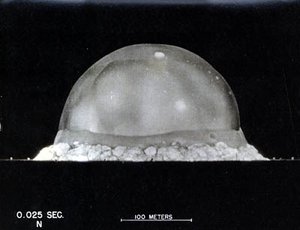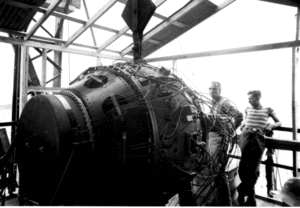Trinity test
|
|
The "Trinity" test was the first test of a nuclear weapon. It occurred on July 16, 1945. A plutonium bomb was tested, the type of weapon later dropped on Nagasaki, Japan (the weapon used against Hiroshima was powered by uranium, a type not tested prior to its use in World War II).
| Contents |
Background
In the winter months of 1938-39 an undeclared wartime atmosphere was preoccupying the citizens of most of the nations of Europe, East Asia and North America. During this period, Lise Meitner, who had fled Austria for Stockholm, and Otto Robert Frisch explained nuclear fission which was observed in Otto Hahn's laboratory in Berlin. Word of Meitner's and Frisch's explanation reached the United States in January 1939, via Niels Bohr, which triggered a scientific and technological activity which was to culminate in the Trinity site test in July 1945. These results would later end the war which by then had engaged the nations of the world.
Research, design, test, and production
From January 1939, small groups of scientific researchers at Columbia, Princeton, and California worked to determine whether fission was feasible. After three years, the result was known: a fissile chain reaction would work. Starting in January 1942, for two years, an engineering project (the Manhattan project) embarked on the design of plants to produce fissile material in large enough quantities for wartime. Industrial companies were contracted with to produce these quantities. Pilot plants actually produced a few grams of fissile material. Three separate production methods were simultaneously begun, as it was not yet known which production methods would be successful. During this time, the Los Alamos National Laboratory for designing nuclear weaponry was established. From January 1944 to July 1945, the large-scale production plants were set in operation, the fissile material thus produced was used to determine the features of the weapons. Multi-pronged research was undertaken to follow several angles of attack against the problem of bomb design. By July 1945, the Trinity test demonstrated the soundness of the bomb design. Bet91
Predictions for the test result
Betting pools were set up among the observers for the results of the test. Some predictions ranged from zero, a dud, to 18 kilotons (predicted by I. I. Rabi), to destruction of the state of New Mexico, to ignition of the atmosphere. As it turned out, Rabi won the bet, with a test result of 18.6 kilotonsHer93.
Site for the test

The site was part of the Alamogordo Bombing Range, now the White Sands Missile Range. The test site is at the northern end of the Range, between the towns of Carrizozo and Socorro, New Mexico in the Jornada del Muerto Desert in the southwestern United States (Template:Coor d). The culmination of the Manhattan Project, the event was code-named "Trinity", using the device code-named "Gadget".
Origin of the name
The exact origin of the name is not known, but it is often attributed to laboratory leader J. Robert Oppenheimer as a reference to the poetry of John Donne. Oppenheimer had been exposed to Donne primarily through his former girlfriend Jean Tatlock, who had committed suicide in July 1944. In 1962, General Leslie Groves wrote to Oppenheimer on the origin of the name, asking if he had chosen it on the basis that it was a common name to rivers and peaks in the West and would not attract attention. "I did suggest it, but not on [that] ground... Why I chose the name is not clear, but I know what thoughts were in my mind. There is a poem of John Donne, written just before his death, which I know and love. From it a quotation: 'As West and East / In all flatt Maps—and I am one—are on, / So death doth touch the Resurrection.'" ("Hymn to God My God, in My Sicknesses"). Oppenheimer continued, "That still does not make a Trinity, but in another, better known devotional poem Donne opens, 'Batter my heart, three person'd God;—.' Beyond this, I have no clues whatever." (Holy Sonnets XIV).Rho86
Logistics
There was a pre-test explosion of 100 tons of TNT on May 7 to calibrate the instrumentation. For the actual test, the plutonium core nuclear weapon, nicknamed the gadget, was placed on the top of a 20-metre steel tower for detonation. It had been assembled at the nearby McDonald Ranch House, the components arriving on July 12. It was assembled on the 13th and winched up the tower the following day. In case of failure, a huge steel canister code-named "Jumbo" was prepared to recover the plutonium; it was shipped to the test site but not used for this purpose. The detonation was planned for 4 a.m. but postponed due to poor weather.
The test result
Trinity_shot_color.jpg
At 05:29:45 local time (Mountain War Time), the device exploded with an energy equivalent to 19 kilotons of TNT (87.5 TJ). It left a crater in the desert 3 metres deep and 330 metres wide. At the time of detonation, the surrounding mountains were illuminated for one to two seconds. The observed colors of the illumination ranged from purple, to green, and eventually to white. The roar of the shock wave took 40 seconds to reach the observersHer93. The shock wave was felt over 160 km away, and the mushroom cloud reached 12 km. As Los Alamos director J. Robert Oppenheimer watched the demonstration, he later said that a line from the Hindu scripture, the Bhagavad Gita, came to mind:
- "Now I am become Death, the Destroyer of worlds."Hij00
Test director Kenneth Bainbridge, in an attempt to be less poetic or perhaps more so, stated "Now we are all sons of bitches." Richard Feynman claimed to be the only person to see the explosion without the dark glasses provided, relying on a truck windshield to screen out harmful ultraviolet wavelengths.
In the crater the desert sand, which is largely made of silica, melted and became glass of a light green color; this was named trinitite. The crater was filled in soon after the test. The military reported it as an accidental explosion at a munitions dump, and the actual cause was not publicly acknowledged until the August 6 attack on Hiroshima. The Manhattan Project's official journalist, William L. Laurence, had previously put multiple press-releases on file with his office at the New York Times, to be released in case of emergency, ranging from a successful test (the one which was used) to more macabre scenarios explaining why all of the scientists had perished in a single freak accident.
Around 260 personnel were present, none closer than 9 km. At the next test series, Operation Crossroads in 1946, over 40,000 people were present.
Afterward
The area was declared a National Historic Landmark in 1975; the public is admitted on the first Saturdays of April and October. There is still a little residual radiation at the site. The Trinity monument, a rough sided dark stone obelisk around 12 ft (3.65 m) high, marks the explosion hypocenter.
References
- Template:Anb James A. Hijiya, "The Gita of Robert Oppenheimer" Proceedings of the American Philosophical Society, 144:2 (June 2000). [1] (http://www.aps-pub.com/proceedings/1442/Hijiya.pdf) (on Oppenheimer's Gita quote)
- Template:AnbRichard Rhodes, The Making of the Atomic Bomb (New York: Simon and Shuster, 1986). Quotes regarding the naming of the test from p. 571-572.
- Template:Anb Hans Bethe (1991), The Road from Los Alamos. American Institute of Physics ISBN 0-671-74012-1
- Template:Anb James Hershberg (1993), James B. Conant: Harvard to Hiroshima and the Making of the Nuclear Age. 948 pp. ISBN 0394579666 p. 233
External links
- Information for visitors (http://www.atomictourist.com/trinity.htm)
- Nuclear-Weapon Archive (http://gawain.membrane.com/hew/Usa/Tests/Trinity.html)
- The Trinity test (http://www.lanl.gov/history/atomicbomb/trinity.shtml) on the Los Alamos National Laboratory website
- The Trinity test (http://www.sandia.gov/LabNews/LN11-03-00/trinity_story.html) on the Sandia National Laboratories website
- Richard Feynman, "Los Alamos from Below" (http://clsdemo.caltech.edu/archive/00000014/02/FeynmanLosAlamos.htm); Surely, You're Joking, Mr. Feynman.
- Trinity Test Fallout Pattern (http://www.atomicarchive.com/Maps/TrinityMap.shtml)de:Trinity-Test



